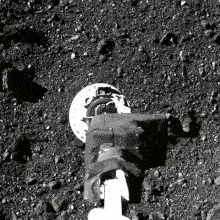It's been several months, but NASA has finally prized the lid off the capsule that returned the Bennu asteroid to Earth.
NASA engineers removed two metal fasteners from the TAGSAM robotic arm that were keeping the lid stuck and trapping the precious cargo inside.
Now the business of analyzing the entirety of the 250g sample for clues about the history of the solar system can begin.
It was back in October 2020 that the robotic arm aboard the OSIRIS-REx spacecraft nabbed a handful of the Bennu asteroid.
Space fans rejoiced in September last year when the craft finally returned to Earth, marking the end of the $1.16 billion mission, one of NASA's most ambitious ever.
NASA engineer Neftali Hernandez uses one of the tools developed to help remove two final fasteners that prevented complete disassembly of the TAGSAM (Touch-and-Go Sample Acquisition Mechanism) head that holds the remainder of material collected from Bennu in the OSIRIS-REx sapce capsule

Timelapse of the 5-minute period on October 20, 2020 when the arm grabbed the sample from Bennu - an asteroid 200 million miles away
According to Eileen Stansbery, division chief for ARES (Astromaterials Research and Exploration Science) at NASA’s Johnson Space Center in Houston, new tools had to be designed to remove the last two screws and open the capsule.
'Our engineers and scientists have worked tirelessly behind the scenes for months to not only process the more than 70 grams of material we were able to access previously, but also design, develop, and test new tools that allowed us to move past this hurdle,' she said.
'The innovation and dedication of this team has been remarkable.
'We are all excited to see the remaining treasure OSIRIS-REx holds.'
Since the sample's triumphant return to Earth in September, NASA managed to only opened the top lid of the capsule, which revealed a curious black dust.
However, the rocky handful from Bennu was stashed away in another smaller component within – which has finally been opened.
The precious cargo is an estimated 8.8 ounces, or 250 grams of rocky material – only about half what you'd find in a average-sized box of cereal.
This mosaic image of asteroid Bennu, composed of 12 PolyCam images collected on December 2, 2018 by the OSIRIS-REx spacecraft from a range of 15 miles (24 km)
In this image from video released by NASA, the Osiris-Rex spacecraft touches the surface of asteroid Bennu on October 20, 2020. The craft later departed for Earth in May 2021
OSIRIS-REx mission history
It was back in September 2016 that NASA launched its OSIRIS-REx spacecraft from Cape Canaveral, Florida.
It arrived at Bennu in December 2018 and mapped the asteroid for almost two years, before finally collecting a sample from the surface in October 2020.
It departed in May 2021 before landing back to Earth on a a remote expanse of military land in Utah on September 24.
But NASA thinks it will be enough to reveal secrets about asteroid composition and 'help us better understand the types of asteroids that could threaten Earth'.
The pebbles and dust from Bennu – which could hit the Earth in 2182 – represent the biggest haul from beyond the moon.
It was back in September 2016 that the OSIRIS-REx spacecraft launched from Cape Canaveral, Florida – and it didn't arrive at Bennu until December 2018.
After mapping the asteroid for almost two years, it collected a sample from the surface on October 20, 2020 before returning home – a round trip of 3.86 billion miles.
Although a straight-line path between Earth and the asteroid is 200 million miles, the overall distance traversed by the spacecraft was much longer because it took a much longer, winding path involving various maneuvers.
The craft containing the precious sample touched down on a remote expanse of military land in the western state of Utah on September 24.
A helicopter delivers a space capsule carrying NASA's first asteroid samples on Sunday to a temporary clean room at Dugway Proving Ground, in Utah. The Osiris-Rex spacecraft released the capsule following a seven-year journey to asteroid Bennu and back
Within two hours of touchdown, the capsule was inside a temporary clean room at the Defense Department's Utah Test and Training Range, having been hoisted there by helicopter.
It was then flown to NASA's Johnson Space Center in Houston, Texas, where experts clad in protective suits opened the initial lid and found black dust.
Scientists had planned to completely disassemble the capsule and extract and weigh the sample, before being set back by two of the 35 fasteners.
Later this spring, the curation team will release a catalog of the OSIRIS-REx samples, which will be available to the global scientific community.
'C-type' asteroid Bennu is high in carbon
Bennu is defined as a carbonaceous chondrite (C-type) asteroid, a group that makes up around 75 per cent of all known asteroids in the solar system – more than any other type.
C-types are darker than other asteroids due to the presence of carbon and are some of the most ancient objects in the solar system – dating back to its birth.
According to experts, volatile-rich C-types, such as Bennu, have been relatively untouched since they were formed billions of years ago.
Bennu is thought to have formed in the first ten million years of our solar system's history – so more than 4.5 billion years ago.
Due to the prevalence of C-type asteroids, information gleaned from Bennu is likely to be applicable to many other asteroids in the solar system.
 (1).png)
 11 months ago
16
11 months ago
16


















